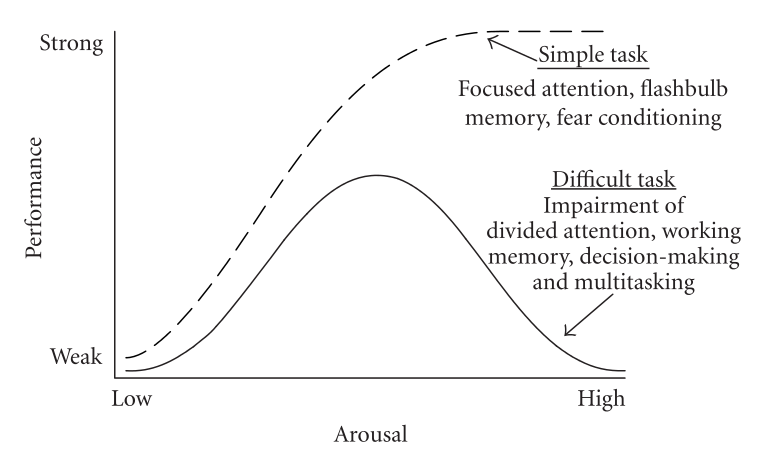Insight #7: Effectiveness and Arousal in Introverts and Extroverts
Is it better to be highly or rather low aroused while solving complex tasks? In what is the introvert going to defeat the extrovert? Enjoy the read!
Yerkes-Dodson Law
Two psychologists, Robert Yerkes and John Dodson, in 1908 described the law that is now known as Yerks-Dodson Law. The researchers have discovered that the performance effectiveness of various activities increases with physical and/or mental arousal, but only until a certain point of stimulation. When the arousal becomes too high, the performance of tasks/activities decreases. In situations of extreme stimulation there may be no effectiveness at all - such a person is then immersed in chaos and may not be able to organize and coordinate his/her behaviour (such a situation may occur e.g. in case of overdose of psychoactive substances such as amphetamine).
What's more, psychologists have noticed that there is no such thing as an optimal level of arousal that would be ideal for any kind of task. It turned out that for difficult tasks, optimal arousal is much lower than for easy tasks! This is because too much agitation has a negative effect on concentration, which is required for complex tasks. The high excitement proved to be better for easy tasks - thanks to it, the motivation to perform the task is longer at a high level and it increases physical endurance to perform tasks that are simple or monotonous. The area in the brain, which mainly regulates the processes described above, is the retinal formation.

Yerkesa-Dodsona Law illustrated
image source
The exact reasons for the loss of efficiency when exceeding a certain arousal level are not known. This is certainly accompanied by a reduction in cognitive capacity and, as a result, lower working memory capacity and poorer retrieval of information from long-term memory, as well as various effects caused by the release of stress hormones (corticosteroids).
Intro- and extra- arousal!
The concepts of introversion and extroversion introduced to science by Carl Gustav Jung are described in literature in very different ways, sometimes completely diverging from their original meaning. But let's take a look at what Hans Eysenck, one of the most important theorists of temperament and personality psychology, had to say about it. And what has the Yerkes-Dodson's law to do with it?!
Eysenck understood intriversion-extroversion as one of the three basic dimensions of personality, with which we can describe a person. According to him, the "intensity" of extroversion in humans has a strictly biological basis and influences the extent to which a person shows such features as sociability, looking for new experiences or assertiveness.
Eysenck believed (which was later confirmed by an empirical investigation) that reticular formation is naturally more active in introverts. This results in the fact that introverts are characterized by a chronically higher cortical excitation level than extraverts. Thus a specific stimulus will have different stimulation value for an extrovert and an introvert, so they will feel this stimulus with a different intensity. Obviously, this also affects complex situations or events, such as functioning at work, at school or in social activities.
Arousal in introverts emerges quicker and more intensively, but reactive inhibition (forgetting learned information or reactions) appears later. Therefore, they often experience the impression that "too many things are going on" and prefer more intimate social situations. Extroverts in contrast need many stimuli to increase the level of excitement, and this is why they undertake a continuous variety of activities in search of new sensations, people or activities that can provide them with desired stimulus.
The Ultimate Arousal?
How do the differences in excitement between introverts and extroverts come under the law of Yerkes-Dodson?
Extroverts (on average) will be more effective than introverts in situations of high stimulation value, i.e. situations with multiple stimuli, where stimuli are new or chaotic and require intensive processing on multiple levels - such an arousal will decrease efficiency in introverts. However, they will be better in situations of low stimulative value, surpassing extroverts for whom it can be too tiring and could cause their minds too scattered and hungry for stimuli.

The graph shows that the most positive mood and learning sensitivity is found in introverts at a lower excitement level than in extroverts. (Eysenck & Hebb, 1967)
image source
We usually choose the appropriate stimulation level for our task or try to modify it so that it will be the most optimal for us. And so, the introvert during solving the task of high stimulation value will first decrease this value in various ways, e.g. by focusing on developing a clear task solution plan or on the preparation many supporting tools for the task. The introvert will prefer learning in silence, while the extrovert will prefer studying with some kind of music, television or even a crowd of people talking in the background. The fact that introverts choose other professions than extroverts is also a consequence of the regulation of the degree of stimulation in our lives. It is very unlikely that an extrovert will become a firewatch in a national park, sitting alone in the tower in silence :)
It should be emphasized that real differences in efficiency between introverts and extroverts are only revealed in situations where people do not have the possibility of self-regulation of stimuli - so it cannot be entirely said that extroverts are "better" in solving difficult tasks and introverts are better in easy ones. One can only say that the extrovert have naturally more optimal arousal for difficult tasks.
Finally, I would like to recall the words of the author of the terms presented in this article, Carl Gustav Jung:
There is no such thing as a pure introvert or extrovert. Such a person would be in the lunatic asylum.
Literature
Eysenck, H. J. (2013). Learning theory and behaviour therapy. Readings in Clinical Psychology, 349.
Gray, J. A. (1991). The neuropsychology of temperament. In Explorations in temperament (pp. 105-128). Springer, Boston, MA.
Strelau, J. (2012). Psychologia temperamentu. Wydawnictwo Naukowe PWN.
Matthews, G., & Gilliland, K. (1999). The personality theories of HJ Eysenck and JA Gray: A comparative review. Personality and Individual differences, 26(4), 583-626.
Yerkes, R. M., & Dodson, J. D. (1908). The relation of strength of stimulus to rapidity of habit‐formation. Journal of comparative neurology, 18(5), 459-482.
Previous entries in the Insight series:
- Insight #1: Brand new psychology series on Steemit! What is insight?
- Insight #2: What emotions are and what are they really for?
- Insight #3: Personality Trait Theory - psychological theory that lead Donald Trump and Brexit to WIN
- Insight #4: Attributions - how and why we judge ourselves differently from others
- Insight #5: Verbal thinking - a "hardfork" of speech
- Insight #6: Do we see more than we suppose? Two separate vision systems hypothesis
SteemSTEM is a community driven project which seeks to promote well written/informative Science Technology Engineering and Mathematics postings on Steemit. More information can be found on the @steemstem blog. For discussions about science related topics or about the SteemSTEM project join us on steemSTEM chat.


Thanks guys!
They happen to have 2 different operative systems for the same hardware, one is not better than the other, just handle things differently
In theory. In practice Linux runs the same hardware way better than Windows =P.
pwned xD
That like comparing facebook/microsoft VS steemit/linux 2 different concepts way far apart xD
Nice article i very like psychology!